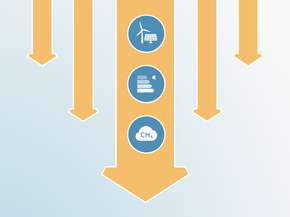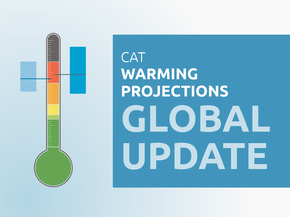Assumptions
Historical emissions
Historical emissions in South Korea were taken from the PRIMAP National Historical Greenhouse Gas Emissions Database (Gütschow, Günther and Pflüger, 2021). This data is provided in AR4. The latest historical datapoint in this set is 2019. The CAT develops 2020 estimates either by sector, or by gas. For South Korea we use the gas method, assuming that CO2 emissions follow the 2020 growth rate observed in the Global Carbon Budget (Le Quéré et al., 2020), while non-CO2 emissions follow the five-year historical trend.
NDC and other targets
The updated 2021 NDC sets a new target of 40% below 2018 levels (total emissions excl. LULUCF in 2018 compared to net emissions in 2030 – incl. reductions from LULUCF and international credits). The government report on the NDC update, published in October 2021, provides a breakdown of emissions per sector, in addition to details on targeted removals from LULUCF, CCUS, and overseas (Republic of Korea, 2021b). We convert the domestic and overall targets from SAR to AR4 following the method outlined below.
We recalculate the 2020 NDC with this information on the contribution of LULUCF sinks and international credits. This results in a 1 MtCO2e increase to 541 MtCO2e from our previous calculations that used assumptions on the use of LULUCF and international credits from South Korea’s first NDC (see assumptions in September 2021 assessment).
South Korea uses GWP values from the IPCC’s Second Assessment Report (SAR). We convert to AR4 GWP values to ease comparison of countries’ targets and emission trajectories. We use detailed emissions data per gas from the national inventory (SAR), and the SAR/AR4 GWPs to derive a full emissions dataset in AR4. We use the ratio of total emissions in SAR and AR4 in 2017 to convert the BAU to AR4 (the annual difference between SAR and AR4 is around 4.5 MtCO2e, with low variance). We apply the reduction stated in the NDC to the total emissions in AR4 GWPs.
South Korea’s 2050 carbon neutrality scenarios present 2050 emissions targets for each sector, in addition to details on targeted removals from LULUCF and CCUS. The CAT considers total emissions excl. LULUCF in 2050. The value is derived from the information provided and converted to AR4 by multiplying the value in SAR with the ratio of the 2017 values in AR4 and SAR. We assume that the target values presented cover all GHGs.
2020 pledge
BAU projections for the 2020 pledge were taken from the Third National Communication (SAR) (Republic of Korea, 2012). We convert the BAU to AR4 GWP following the method described above. We no longer consider the 2020 pledge when calculating the global temperature rise associated with the aggregated pledges of all countries.
Current policy projections
Current policy projections are calculated based on emissions reductions below the BAU scenario from the 7th Edition of APEC Energy Demand and Supply Outlook (APERC, 2019) and the US EPA non-CO2 emission projections until 2030 (US EPA, 2019). Non-energy related CO2 emissions are assumed to remain constant at the 2020 level.
The APEC BAU is not used as a current policy scenario as its forecast for renewables share in power generation (7.6%) is comparable to the 2020 share of renewables (6%) (IEA, 2021b) and much lower than other studies, which range from 14% to 20% (Keramidas et al., 2018; Hong et al., 2019; Wood Mackenzie, 2019).
With no change to the five-year trend in renewables share, this would reach around 15% in 2030. We therefore consider the Wood Mackenzie projection for the upper bound of current policies projections – 17% in 2030, representing a slight increase in activity before 2030, but missing the target of 20.8%. We derive the emissions projection from the APEC BAU by assuming additional generation from renewables replaces coal-fired power generation.
For the lower bound current policies projections, we consider the power generation level and mix presented in the Ninth Electricity Plan in December 2020 (MOTIE, 2020).
The average electricity CO2 emission factors for each fossil fuel type in South Korea were assumed to be similar to the values forecast for Japan in the IEA’s World Energy Outlook 2020 (IEA, 2020).
COVID-19 impact
We apply a novel method to estimate the COVID-19-related dip in greenhouse gas emissions in 2021 and the deployment through to 2030. The uncertainty surrounding the severity and length of the pandemic creates a new level of uncertainty for current and future greenhouse gas emissions.
We first update the current policy projections using most recent projections, usually prepared before the pandemic. We then distil the emissions intensity (GHG emissions/GDP) from this pre-pandemic scenario and apply to it most recent GDP projections that take in to account the effect of the pandemic. To capture a range, we use GDP projections from the IMF 2021-2026 and OECD for 2021 (OECD, 2020; IMF, 2021a, 2021b). After the last year in each projection, we use the GDP growth until 2030 that was used as a basis for the original pre-pandemic current policy scenario.
The quantification of South Korea’s current policies projections focuses on energy-related CO2 emissions reductions. For scenarios that already consider the impact of COVID-19, we do not adjust energy-related CO2 emissions, to avoid double-counting.
Global Warming Potentials values
The CAT uses Global Warming Potential (GWP) values from the IPCC's Fourth Assessment Report (AR4) for all its figures and time series. Assessments completed prior to December 2018 (COP24) used GWP values from the Second Assessment Report (SAR).
Further analysis
Latest publications
Stay informed
Subscribe to our newsletter




